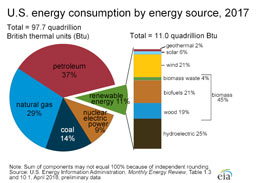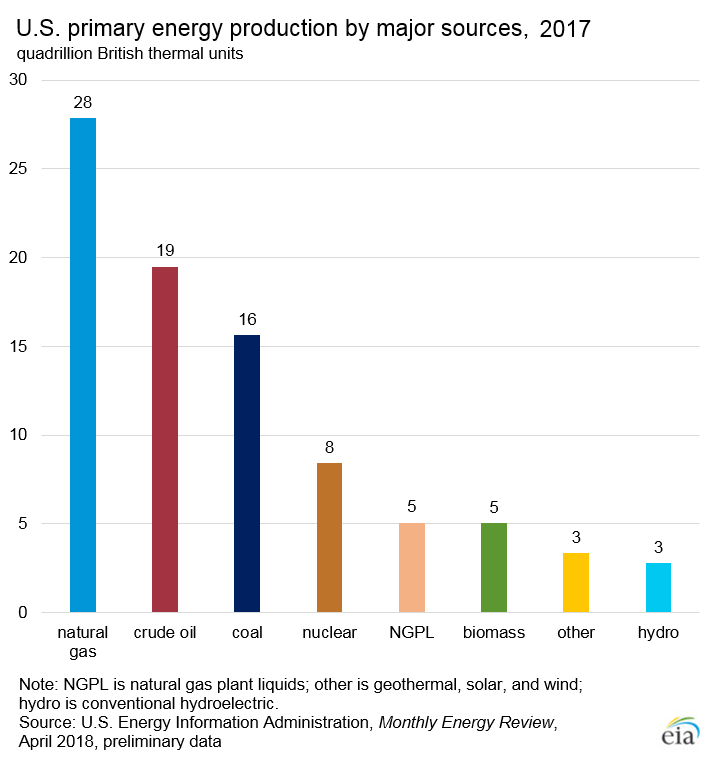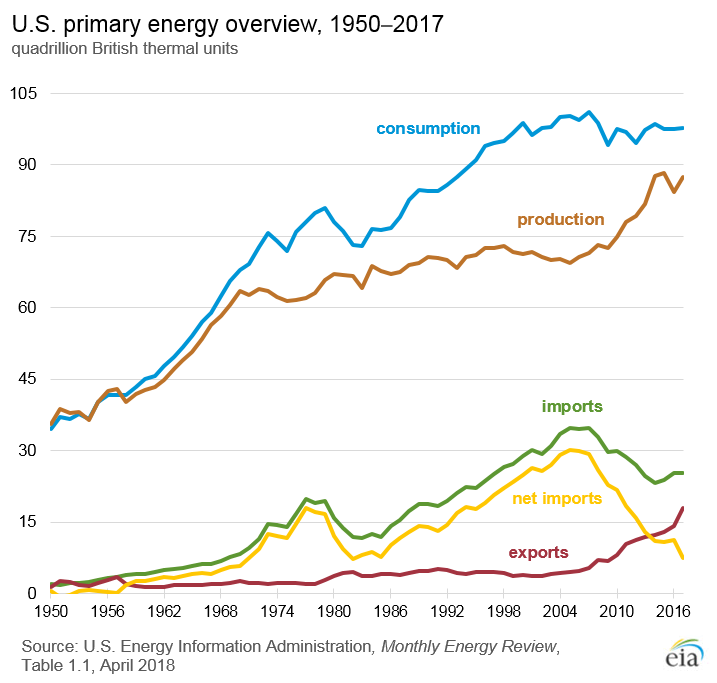The United States uses a mix of energy sources
The United States uses and produces many different types and sources of energy, which can be grouped into general categories such as primary and secondary, renewable and nonrenewable, and fossil fuels.
Primary energy sources include fossil fuels (petroleum, natural gas, and coal), nuclear energy, and renewable sources of energy. Electricity is a secondary energy source that is generated (produced) from primary energy sources.
Energy sources are measured in different physical units: liquid fuels in barrels or gallons, natural gas in cubic feet, coal in short tons, and electricity in kilowatts and kilowatthours. In the United States, British thermal units (Btu), a measure of heat energy, is commonly used for comparing different types of energy to each other. In 2017, total U.S. primary energy consumption was equal to about 97.7 quadrillion (97,728,000,000,000,000) Btu.
There are five major primary energy consuming sectors. Their shares of total primary energy consumption in 2017 were:
- Electric power—38.1%
- Transportation—28.8%
- Industrial—22.4%
- Residential—6.2%
- Commercial—4.5%
- Natural gas—31.8%
- Petroleum (crude oil and natural gas plant liquids)—28.0%
- Coal—17.8%
- Renewable energy—12.7%
- Nuclear electric power—9.6%
The electric power sector generates most of the electricity in the United States, and the other four sectors consume most of that electricity.
The pattern of fuel use varies widely by sector. For example, petroleum provides about 92% of the energy used for transportation, but only 1% of the energy used to generate electricity.
Domestic energy production is equal to about 90% of U.S. energy consumption in 2017
In 2017, the amount of energy produced in the United States was equal to about 87.5 quadrillion Btu, and this was equal to about 89.6% of U.S. energy consumption. The difference between the amount of total primary energy consumption and total primary energy production was mainly the energy content of net imports of crude oil.
The three major fossil fuels—petroleum, natural gas, and coal—combined accounted for about 77.6% of the U.S. primary energy production in 2017:
The mix of U.S. energy consumption and production has changed over time
Fossil fuels have dominated the U.S. energy mix for more than 100 years, but the mix has changed over time.
Coal production peaked in 2008, trended down through 2016, and increased about 6% in 2017. Coal production in 2017 was about equal to production in 1979. The main reason for the general decline in U.S. coal production in recent years is the decrease in U.S. coal consumption for electricity generation.
Natural gas production in 2017 was the second-largest amount after the record high-production in 2015. More efficient and cost-effective drilling and production techniques have resulted in increased production of natural gas from shale and tight geologic formations. The increase in production contributed to a decline in natural gas prices, which in turn has contributed to increases in natural gas use by the electric power and industrial sectors.
Crude oil production generally decreased each year between 1970 and 2008. In 2009, the trend reversed and production began to rise. Production in 2015 and in 2017 was the second and third highest on record, respectively. More cost-effective drilling and production technologies helped to boost production, especially in Texas and North Dakota.
Natural gas plant liquids (NGPL) are hydrocarbon gas liquids (HGL) that are extracted from natural gas before the natural gas is put into pipelines for transmission to consumers. NGPL production has increased alongside increases in natural gas production and reached a record high in 2017. U.S. consumption and exports of HGL have both increased in recent years.
Total renewable energy production and consumption both reached record highs of about 11 quadrillion Btu in 2017. Hydroelectric power production in 2017 was about 2% lower than the 50-year average. Increases in energy production from wind and solar helped to increase the overall energy production from renewable sources. Energy production from wind and solar were at record highs in 2017.










